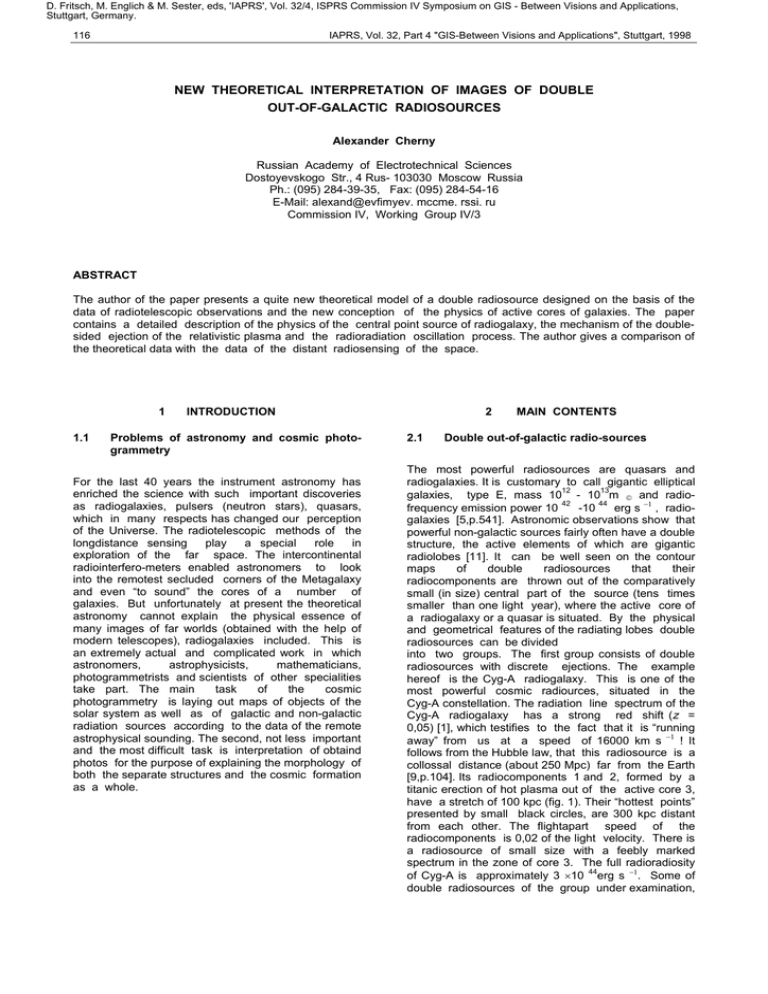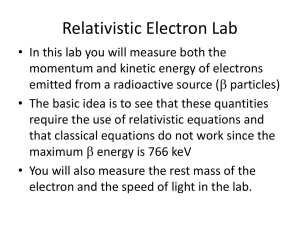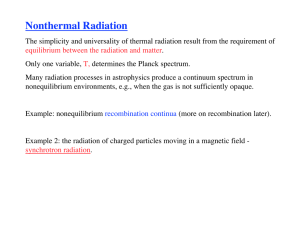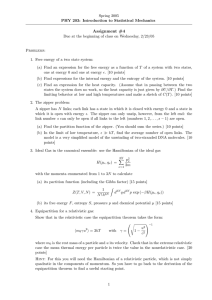NEW THEORETICAL INTERPRETATION OF IMAGES ... OUT-OF-GALACTIC RADIOSOURCES
advertisement

D. Fritsch, M. Englich & M. Sester, eds, 'IAPRS', Vol. 32/4, ISPRS Commission IV Symposium on GIS - Between Visions and Applications, Stuttgart, Germany. 116 IAPRS, Vol. 32, Part 4 "GIS-Between Visions and Applications", Stuttgart, 1998 NEW THEORETICAL INTERPRETATION OF IMAGES OF DOUBLE OUT-OF-GALACTIC RADIOSOURCES Alexander Cherny Russian Academy of Electrotechnical Sciences Dostoyevskogo Str., 4 Rus- 103030 Moscow Russia Ph.: (095) 284-39-35, Fax: (095) 284-54-16 E-Mail: alexand@evfimyev. mccme. rssi. ru Commission IV, Working Group IV/3 ABSTRACT The author of the paper presents a quite new theoretical model of a double radiosource designed on the basis of the data of radiotelescopic observations and the new conception of the physics of active cores of galaxies. The paper contains a detailed description of the physics of the central point source of radiogalaxy, the mechanism of the doublesided ejection of the relativistic plasma and the radioradiation oscillation process. The author gives a comparison of the theoretical data with the data of the distant radiosensing of the space. 1 1.1 INTRODUCTION Problems of astronomy and cosmic photogrammetry For the last 40 years the instrument astronomy has enriched the science with such important discoveries as radiogalaxies, pulsers (neutron stars), quasars, which in many respects has changed our perception of the Universe. The radiotelescopic methods of the longdistance sensing play a special role in exploration of the far space. The intercontinental radiointerfero-meters enabled astronomers to look into the remotest secluded corners of the Metagalaxy and even “to sound” the cores of a number of galaxies. But unfortunately at present the theoretical astronomy cannot explain the physical essence of many images of far worlds (obtained with the help of modern telescopes), radiogalaxies included. This is an extremely actual and complicated work in which astronomers, astrophysicists, mathematicians, photogrammetrists and scientists of other specialities take part. The main task of the cosmic photogrammetry is laying out maps of objects of the solar system as well as of galactic and non-galactic radiation sources according to the data of the remote astrophysical sounding. The second, not less important and the most difficult task is interpretation of obtaind photos for the purpose of explaining the morphology of both the separate structures and the cosmic formation as a whole. 2 2.1 MAIN CONTENTS Double out-of-galactic radio-sources The most powerful radiosources are quasars and radiogalaxies. It is customary to call gigantic elliptical galaxies, type E, mass 1012 - 1013m ¤ and radiofrequency emission power 10 42 -10 44 erg s , radiogalaxies [5,p.541]. Astronomic observations show that powerful non-galactic sources fairly often have a double structure, the active elements of which are gigantic radiolobes [11]. It can be well seen on the contour maps of double radiosources that their radiocomponents are thrown out of the comparatively small (in size) central part of the source (tens times smaller than one light year), where the active core of a radiogalaxy or a quasar is situated. By the physical and geometrical features of the radiating lobes double radiosources can be divided into two groups. The first group consists of double radiosources with discrete ejections. The example hereof is the Cyg-A radiogalaxy. This is one of the most powerful cosmic radiources, situated in the Cyg-A constellation. The radiation line spectrum of the Cyg-A radiogalaxy has a strong red shift (z = 0,05) [1], which testifies to the fact that it is “running away” from us at a speed of 16000 km s ! It follows from the Hubble law, that this radiosource is a collossal distance (about 250 Mpc) far from the Earth [9,p.104]. Its radiocomponents 1 and 2, formed by a titanic erection of hot plasma out of the active core 3, have a stretch of 100 kpc (fig. 1). Their “hottest points” presented by small black circles, are 300 kpc distant from each other. The flightapart speed of the radiocomponents is 0,02 of the light velocity. There is a radiosource of small size with a feebly marked spectrum in the zone of core 3. The full radioradiosity of Cyg-A is approximately 3 u10 44erg s . Some of double radiosources of the group under examination, D. Fritsch, M. Englich & M. Sester, eds, 'IAPRS', Vol. 32/4, ISPRS Commission IV Symposium on GIS - Between Visions and Applications, Stuttgart, Germany. Cherny for example Centaur-A, ejections [2,p.477]. 117 sometimes repeat their The radiogalaxies and quasars with extended lobes 1 and 2 (formed by continuous two-way ejections of the relativistic plasma out of the active core 3) belong to the second group of radiosources (fig. 2). Galaxy 3C449 is an example of such a radiosource. The maximum of radioradiation falls at the narrow part of the lobes, where the movement speed of the relativistic particles is pronounced. The frontal parts of the lobes are expanded and have a less intensive radiosity which is attributed to an expansion of the relativistic gas during braking. T.A.Agekyan emphasizes that such powerful radiosources as Cyg-A, are very rare in the Metagalaxy [1,p.219]. In fact, there have not been detected any sources of the kind in the radius of smaller than 200 Mpc from the Earth. Radioastronomic observations showed that powerful radiosources (radiogalaxies and quasars) are at a distance of 500 4000 Mpc away from us. The physics of non-thermal radiation of radiocomponents is clear enough. This so-called synchrotron radiation occurs when relativistic particles (mainly electrons) are moving in the magnetic field [4]. A valuable contribution to the theory of the synchrotron radiation has been made by Russian scientists. The magnetic and braking radiation was predicted by D.D.Ivanenko and I.Y.Pomeranchuk in 1944. In 1950 D.D.Ivanenko and A.A.Sokolov were awarded the USSR State Prize for having worked out the synchrotron radiation theory. V.L.Ginsburg and I.S.Shklovsky were the first to presume that the mechanism of cosmic radiation was caused by synchrotron radiation of relativistic electrons moving in magnetic fields, stretching for millions of light years [3, 10]. So, the synchrotron radiation, for the first time discovered with manmade accelerators of charged particles, is an ordinary and rather widespread phenomenon in space. Radiosource 3C236, the biggest of the well-known double radiosources, has a stretch of the radiolobes of 5,7 Mpc or 19 million light years [2, p.476]. As radiotelescopes and radiointerferometers have been developing, the number of open double nongalactic radiosources invariably has been growing. But unfortunately their increased number has not made the operation of the gigantic “catapult” (disgorging twoway streams of the relativistic plasma out of the active core of a galaxy or a quasar), clear. None of the well-known hypotheses is capable of explaining their nature somehow plausibly [6,p.542]. It is quite evident that in order to solve this enigma, first of all it is necessary to throw light on the physical secret of active cores, which is “well and truly hidden”. And nevertherless, it is not so hopeless as for the astrophysical decomouflage of active cores. “The light at the end of the tunnel is already seen”. In works [8, 9] we present a new quasar model, which in a general way satisfactorily conforms to the information of the astrophysical observations. Below we shall do our best to explain the physical birth of radiocomponents of double sources on the basis of the new model of active cores of galaxies proposed by us. 2.2 On the birth mechanism of radio lobes of double radiosources According to the modern notions most galaxies have a massive core (m = 10 7- 10 9 m¤) in the center which in many astrophysisists`openion is a black hole [6,p.766]. Any supermassive gravitating body should by time turn into such a state as a result of a gravitational collapse. This was predicted by the general theory of relativity [5]. As most stellar objects are rotating, we have every reason to think that this collapse will result in forming a Kerra black hole. It is grounded in work [8] that the space-time under the horizon of events is imaginary. In this antiworld the gravitational field has two potentials: central and external. Just the external “turned inside out” gravitational field keeps the black hole core from falling into singularity. The black hole attracts the stellar matter of the surrounding galaxy like a gravitational magnet. As the interstellar gas falling onto the black hole, possesses the angular momentum, there should be formed a rotating accretioning disc of the magnetized plasma [7]. The black hole actively absorbs the relativistic mass out of the disc base which falls down in a spiral. The speed of plasma near the horizon of events approaches the light velocity [5,p.118]. When relativistic particles (electrons, protons) cross the horizon of events, an ultrarelativistic explosure takes place, forming an antiparticle and a superhard gamma-quantum [8]. That is why the black hole core, bombarded by relativistic particles and quanta of superhard gamma-radiation is covered with a boiling layer of the annihilating matter. Quasars and radiogalaxies have a high value of the cosmologic red shift in their linear spectra [6, p.295, 1, p.218]. It means that they are flying away from us at unusually high speeds. And this is very important for understanding the physics of radiosources with active cores. The point is that when the body is moving at a relativistic speed, it is noticeably catching up with its gravitational field; it is compressing along its movement and the density of the gravitational matter is increasing. The gravitational field is rarefying behind the moving object and the density of the matter is reducing. The change in the density of the gravitational matter and distortion of the spherical symmetry of the gravitational field cause a shift of the equipotential surfaces (including the horizon of events) relative to the field source along the movement of the quasar towards the compaction zone of the gravitational energy [9]. At the same time the rotating core 1 of the black hole partially strips itself 2 rising above the horizon of events 3, and “disgorges” annihilation products out of the quasar (in the opposite direction of its movement), they are: hard-radiation photons 4 and clots of exploding matter 5, turned (evaporated) by hard radiation into the relativistic gas 6 (fig.3). Under the action of the light pressure relativistic electrons and protons accelerate in the magnetic field 7 of the bare part of the black hole core, generating the synchrotron radiation. Such radiation can be actually seen in the central zone of many non-galactic radiosources. In the “boiler” 8 D. Fritsch, M. Englich & M. Sester, eds, 'IAPRS', Vol. 32/4, ISPRS Commission IV Symposium on GIS - Between Visions and Applications, Stuttgart, Germany. 118 IAPRS, Vol. 32, Part 4 "GIS-Between Visions and Applications", Stuttgart, 1998 itself of the black hole, in the closed space between the horizon of events 3 and the core (under the action of irradiation of the core by quanta of superhard radiation and the annihilation process on its surface) the relativistic gas 9 is very overheated. In most cases rotation of the massive core runs very slowly which does not maintain sufficient cooling of its surface when the energy is being released through the window in the horizon of events. In zones 10, adjoining the core rotation axis ii from which heat liberation does not practically take place, there arises a critical gas pressure. Under the action of this enormous pressure the relativistic gas breaks out in two jets 11 through the lateral channels of the bare part of the core formed by explosures of the annihilating matter. The jets of the relativistic plasma move along the generatrix 12 of the light cone and further along the magnetic lines 13 of the accretion disc 14. The jets 11 are not capable of penetrating into the light cone, as the light pressure goes over the Edington limit there. The mass of the thrown out plasma and the discrete ejections mainly depend on the density of the accretion flow 15 and on “voracity” of the black hole. If a star from the nearest “rounddance” of stars, torn asunder by tide forces, “comes down” through the horizon of events, a gigantic disgorge of the matter out of the active core is to take place. It is not ruled out that the two radiocomponents of the Cyg-A galaxy are an outcome of gigantic disgorges of the relativistic plasma, after the black hole has absorbed a massive star. The initial speed of the hot plasma in the relativistic jets is to be about the light velocity. At such a speed the charged particles should radiate in a very narrow cone along their movement, and their synchrotron radiation will be inaccessible for our radiotelescopes. It can be very well seen on the contour radiomap (fig. 2), where the radiolobes at their base 4 have the radiation intensity close to zero. When moving further in the magnetic field, the relativistic particles are being retarded, and the diagram of their synchrotron radiation is being widened covering the Earth. The radiotelescopes will observe the extended radiocomponents 1 and 2. At a very long distance from the active core the speed of the relativistic particles is noticably falling off, the jets are extending 5, 6 and the radiation intensivity is falling. 3 CONCLUSION The new theoretical model of double non-galactic radiosources (which as a whole is corroborated by the data of the astronomical observations) helps to comprehend the morphology of radiogalaxes and global astrophysical processes connected with them, the echots of which are seen on radiomaps of distant luminaries. References: 1. Agekyan T.A. Stars, Galaxies, Metagalaxy.M.: Science, 1970. 2. Bretcher K. Active galaxies // Frontiers of Astrophysics.- M.: World, 1979, pp.459-493. 3. Ginzburg V.L. Theoretical physics and astrophysics.- M.: Science, 1975. 4. Zhelesnyakov V.V. Radiation in astrophysical plasma.- M.: Yanys-K, 1997. 5. Zeldovich Ya.B., Novikov I.D. Gravitation theory and evolution of stars.- M.: Science, 1971. 6. Space Physics.-Soviet encyclopaedia, 1986. 7. Heyvaerts G. MHD - forces in astrophysical disks and jets // Advances in solar system magnetohydrodynamics.- M.: World, 1995., pp. 410-434. 8. Cherny A.N. Relativistic process in the womb of the black hole // Geodesy and Cartography, 1997.-N 2.- pp. 19-26. 9. Cherny A.N. On nature of quasars // Geodesy and Cartography, 1997.- N 5.- pp. 18-23. 10. Shklovsky I.S. Problems of Modern Astrophysics.- M.: Science, 1982. 11. Verschuur C.L., Kellerman K.I., eds., Galactic and Extragalactic Radio Astronomy, Springer-Verlag. Berlin, 1974. D. Fritsch, M. Englich & M. Sester, eds, 'IAPRS', Vol. 32/4, ISPRS Commission IV Symposium on GIS - Between Visions and Applications, Stuttgart, Germany. Cherny 119 Fig. 1 Double discrete radiosource ( Cyg - A ) Fig. 2 Radiosource with extended radiolobes (galaxy 3C 449) D. Fritsch, M. Englich & M. Sester, eds, 'IAPRS', Vol. 32/4, ISPRS Commission IV Symposium on GIS - Between Visions and Applications, Stuttgart, Germany. 120 IAPRS, Vol. 32, Part 4 "GIS-Between Visions and Applications", Stuttgart, 1998 Fig. 3 Active core of a double radiosource




